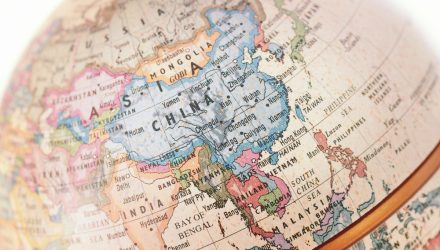International equities have long trailed domestic counterparts, prompting asset allocators to carry underweight ex-U.S. exposure. However, some experts believe the time is right for money managers to increase their exposure to markets outside the U.S. And those market observers believe Asia is the place to start. While stocks in China, the region’s largest economy, are struggling, India and Japan are among the world’s best-performing markets. In the case of India, that’s a now long-running theme. For investors looking to nibble at Asian equities and stocks, some of the volatility may be mitigated with dividends. Enter the KraneShares S&P Pan Asia Dividend Aristocrats ETF (KDIV).
KDIV, which follows the S&P Pan Asia Dividend Aristocrats Index, allocates more than a third of its weight to Chinese stocks. That’s not surprising owing to the size of that country’s financial markets and its status as the largest emerging markets dividend payer in dollar terms. However, the exchange traded fund has other benefits to consider.
KDIV Could Be at the Right Place at the Right Time
KDIV’s more than 28% allocation to Japan shouldn’t be overlooked. Not at a time when Japanese stocks are soaring and not when companies are increasingly embracing shareholder rewards, including both dividends and share repurchase programs.
“Recent corporate governance reforms are instilling newfound momentum and pressure on Japanese companies to improve shareholder value. As a result, Japan’s ROE and P/B are improving, presenting investors with a once in a generation rerating opportunity in a once forgotten market,” according to J.P. Morgan Asset Management.
KDIV’s multi-country approach is relevant because the Asia-Pacific region is home to large economies with varying themes acting as catalysts.
“Corporate governance changes favor Japan,” added J.P. Morgan “In particular, some markets in Asia are going through attractive top-down and bottom-up changes.”
Australia, long one of the more dependable dividend markets outside the U.S., is KDIV’s third-largest country exposure at a weight of 14.18%. As is the case in the U.S., Australian stocks recently hit records, but are also beholden to inflation data. That country is often a high dividend market, but the trailing 12-month dividend yield on the MSCI Australia Index is 3.67%, which isn’t alarmingly high and implies some room for payout growth.
It’s expected that if inflation there remains subdued, the National Bank of Australia will cut interest rates, which could stoke renewed demand for dividend stocks, potentially benefiting KDIV in the process.
For more news, information, and analysis, visit the China Insights Channel.

